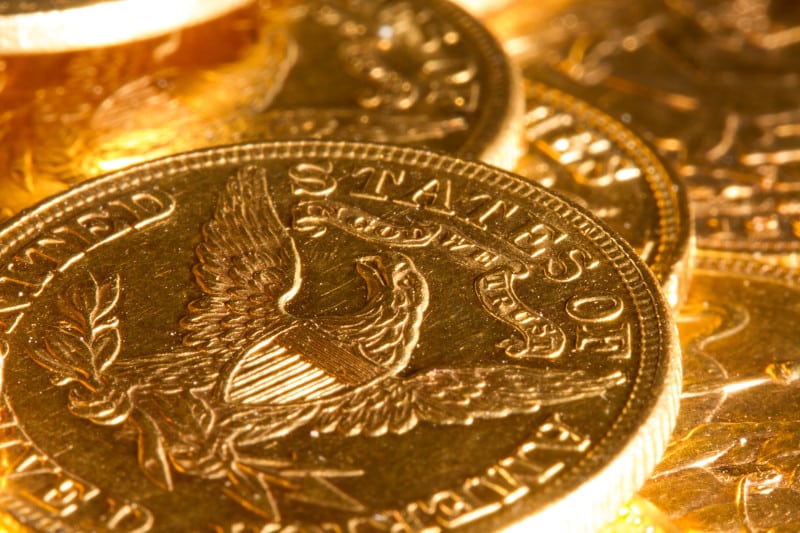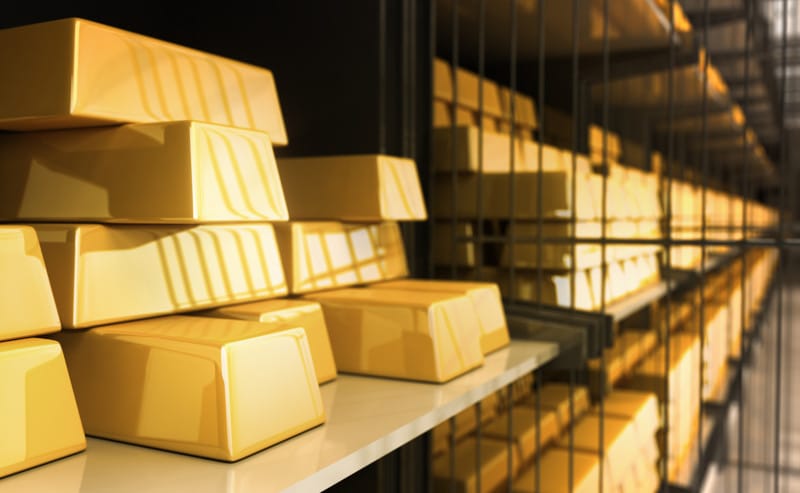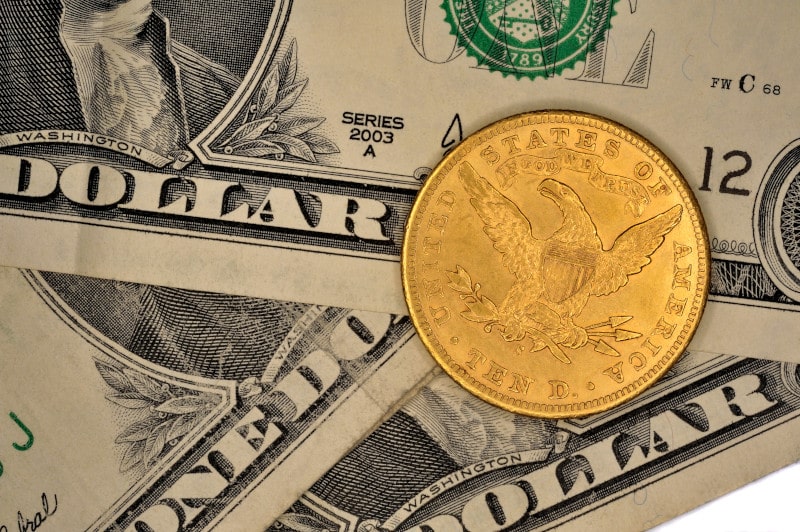3 Easy Steps to Roll Over Your TSP Into an IRA
Over 70 million Americans today have 401(k) accounts, making them one of the most popular types of retirement accounts Federal employees don’t have 401(k) accounts, but instead have the Thrift...
Precious Metals

Many people today are starting to buy gold to help protect their wealth against the threats of inflation and potential recession. Gold’s reputation as a safe haven asset that maintains value over the long term continues to make it a popular choice for those fearful of the economic uncertainty that surrounds us.
But that’s not the only reason people buy gold.
There are many people who buy gold because they understand the intrinsic weakness of the fractional reserve banking system and the possibility of the collapse of fiat currency. Monetary history is replete with fiat currencies that have come and gone, from precious metals-backed currencies that were debased over time to paper currencies that have long since disappeared.
For people who buy gold for these reasons, they understand that the monetary struggle of our day is gold versus the dollar. They believe that it’s only a matter of time before the dollar is swept aside, replaced by something else, which could very well end up being gold.
Gold has served as a monetary metal for millennia, and recent moves in other parts of the world have some experts warning that a gold-backed currency may eventually replace the dollar. When it comes to gold versus the dollar, which do you think will prevail?
Gold and the dollar haven’t always been rivals. In fact, for portions of American history the two were synonymous, as the dollar was defined as a weight of gold.
That all changed in the 20th century, and now gold and the dollar have taken two vastly different paths. In order to really understand why, we need to look at gold and the gold price throughout American history.

The Coinage Act of 1792 established the US Mint and the US system of currency that exists today. In particular it defined the dollar as 371 4/16 (371.25) grains of pure silver.
The gold eagle $10 coin, by contrast, was required to have 247 4/8 (247.5) grains of pure gold. That meant that the dollar was, in gold terms, equivalent to 24.75 grains of pure gold.
Remember that there are 480 grains per troy ounce of gold, so this valued gold at roughly $19.39 per ounce, and established the gold to silver ratio at 15:1, meaning that it would take 15 ounces of silver to equal the value of 1 ounce of gold.
This introduced the problem of bimetallism, which was a recurring problem in those countries that tried to circulate both gold and silver coinage side by side. This resulted in numerous changes to the silver and gold content of US coins throughout the 19th century, which is why, for instance, two silver half dollars ended up having less silver in them than a silver dollar.
While many European countries began to move from silver or bimetallic standards to the gold standard in the 1870s, the US move to the gold standard came comparatively late, in 1900.
The Gold Standard Act of 1900 formalized de jure what had been a de facto standard since the Coinage Act of 1873, and officially placed the United States on the gold standard. It defined the dollar as 25 8/10 grains of gold nine-tenths fine, or in other words 23.22 grains of pure gold. Thus an ounce of gold was equivalent to $20.67.
This system remained in place until President Franklin Delano Roosevelt issued Executive Order 6102 on April 5, 1933, which forbade private ownership of gold with certain limited exceptions. Congress rubber-stamped that seizure with the Gold Reserve Act of 1934, which also allowed the President to change the value of the dollar.
Within a day of the Gold Reserve Act’s passage, FDR issued Presidential Proclamation 2072, which defined the dollar as 15 5/21 grains of gold, nine-tenths fine, or 13.71 grains of pure gold. This set the value of an ounce of gold as $35.
Note that this isn’t an increase in the gold price, it’s rather a devaluation of the dollar, from 23.22 grains of gold to 13.71 grains. This was to set the stage for the future, as sustained increases in the price of gold normally correspond with sustained decreases in the purchasing power of the dollar.

At the conclusion of World War II, the Western world established a new international monetary system to govern international trade through the Bretton Woods system. The British pound was no longer the world’s dominant currency, instead it was replaced by the US dollar.
While the dollar was not fully backed by gold, nor could individuals acquire gold, foreign nations were still allowed to redeem their dollars for gold at the Treasury’s “gold window”. Since this was judged to be something that wouldn’t likely happen, the US government took advantage of its status as the world’s reserve currency to create more and more dollars in the 1950s.
By the early 1960s, numerous problems began to creep in. For one thing, European nations began to redeem their dollars for gold.
International gold markets also realized what was going on, and the London gold price on numerous occasions broke above the official $35 per ounce valuation. The London Gold Pool was created in 1961 to try to defend the $35 per ounce valuation, but eventually collapsed in 1968 due to the impossibility of doing so.
Gold redemptions continued apace, leading to fears that US gold reserves might eventually be exhausted. So President Nixon decided to take action.
On August 15, 1971, President Nixon officially closed the gold window, permanently severing any official relationship between the dollar and gold. From that day forward, the gold price was able to move freely without threat of government intervention.
Despite that, the US government still devalued the dollar further, officially valuing gold at $38 an ounce in December 1971 and $42.22 an ounce in February 1973. But by that point the horse was already out of the barn.
The gold price was already at nearly $70 an ounce by that point, and it reached $100 an ounce for the first time in May 1973. It never looked back.
Even better for Americans, President Ford issued Executive Order 11825 on December 31, 1974, repealing the Executive Orders that had banned Americans from owning gold. From that point forward, Americans were once again free to buy and sell gold just like they had been before 1933.
The decades since have underscored just how destructive US monetary and fiscal policies have been, as the dollar has lost significant amounts of purchasing power. The dollar in 1971 was officially valued at 1/35 ounce of gold, whereas today that same dollar purchases less than 1/3300 ounce of gold.
That’s a 99% loss of purchasing power in a little over 50 years.
The flip side of that, however, is that the value of gold is far higher today, over 9,000% higher in fact. That highlights the fact that the more value the dollar loses, the more value gold gains.
In addition to the normally inverse relationship between gold and the dollar, there are a few other things that drive the gold price too. Increased demand for gold will generally drive the gold price higher, while increased supply of gold will generally drive the gold price lower.
Major sources of gold demand include coin and bar demand, whether individual, institutional, or exchange-traded funds (ETF), the jewelry industry, and even the technology sector. Gold demand has increased significantly in recent years, which has helped boost the gold price.
Central banks have also been net buyers of gold in recent years, which has contributed to overall gold demand.
The primary sources of gold supply are mining and recycling. Gold mining takes significant time, resources, and capital, and so mining output generally remains relatively steady.
Gold recycling can take place through removing gold from old recycled electronics, or buying gold jewelry and coins from individuals and melting them down. When gold prices increase, it becomes more profitable to recycle gold, so gold supply could increase through recycling even if mining production doesn’t increase significantly.
Just because gold prices are quoted in dollars doesn’t mean that currency fluctuations can’t impact the gold price. Local gold markets often sell gold in their local currencies, so changes in those local currencies can impact gold prices and demand for gold.
Right now the US dollar is worth 85.5 Indian rupees. At the current gold price of around $3,344, that would mean that an ounce of gold is about 286,000 rupees, or if you’re familiar with Indian numbering terminology, 2.86 lakh rupees.
If the rupee were to strengthen against the dollar, say to 70 rupees to the dollar, and the price of gold were still be $3,344, gold’s rupee value would fall to about 234,000 rupees (2.34 lakh).
That could spur gold demand in India, which is one of the world’s largest gold markets. If demand is stimulated enough, that increased demand could in turn drive up the dollar price of gold on international markets.
So even though the relationship between the US dollar and gold is an important one, movements in other currencies can also impact the gold price.

While the dollar doesn’t seem about to collapse anytime soon, many are wondering just how long ballooning government debt and problematic inflation will last. The dollar’s devaluation over the past several decades has resulted in higher prices and reduced standards of living, and has led to questions about sustainability.
Continued rumors of gold-backed currencies for international trade, as well as continued gold buying by China and Russia , have led to speculation that the dollar may eventually be replaced as the world’s reserve currency by a new gold-backed currency. While that may not happen immediately, there’s still a sense of unease about the dollar’s future.
As long as the federal government continues running up debt, and the Federal Reserve keeps inflating the money supply, the value of each dollar will continue to decrease. While this would negatively impact American consumers, it could be good for gold.
The long term trend for the gold price seems to be one of continued gains, with the 21st century so far being a great time for the gold price. No wonder so many Americans today are trying to buy gold.
With numerous gold buying options to choose from, whether it’s a direct cash purchase of gold or buying gold through a gold IRA, there’s something for everyone. Goldco has helped thousands of customers, with budgets from small to large, benefit from owning gold.
If you’re looking to help protect your hard-earned assets against further devaluation of the dollar, call Goldco today to learn more about how gold can help safeguard your savings.
This article was originally published in September 2023 and was updated in June 2025.

